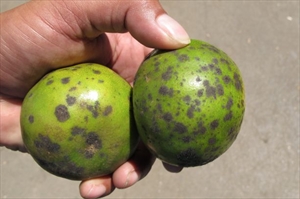Citrus sooty blotch, black mould, black mildew
Pacific Pests, Pathogens, Weeds & Pesticides - Online edition
Pacific Pests, Pathogens, Weeds & Pesticides
Citrus sooty blotch (316)
Meliola citricola
South, East and Southeast Asia, Oceania. It is present in Fiji, Papua New Guinea, Samoa, and Solomon Islands.
Citrus species.
Sooty blotch is caused by a fungus that infects leaves and fruit. It is unlikely that it affects yield, although, if infection is severe it may block sunlight, reducing photosynthesis, and, in turn, that could lower fruit production.
On the leaves, the fungus colonises both upper and lower surfaces causing black, circular spots, up to 5 mm diameter (Photos 1&2). It infects young leaves and fruit, but growth is slow so that the spots are seen only when leaves and fruit mature (Photo 3). Spores are produced in the black spots, and these are spread by wind during wet or humid weather when there are heavy dews. The fungus does best on densely shaded trees.
Sooty mould is a 'cosmetic disease'. The spots on the fruit are shallow and there are no rots in the flesh; nevertheless, the spots are unsightly and they reduce the market value of the fruit.
The spots on the fruit caused by sooty blotch are often mistaken for a sooty mould. There are reports that sooty blotch has been found with Capnodium citri, one of the sooty moulds that grow on citrus (see Fact Sheet no. 051). However, spots caused by sooty moulds depend on honeydew from sap-sucking insects, and that is not the case for spots caused by sooty blotch.
CULTURAL CONTROL
During growth
- Prune trees to improve air movement so that leaves and fruit dry faster after rain or dew. The fungus needs water for the spores to germinate, infect and spread. Avoid over-pruning: i) removing too much will reduce the crop, and ii) damage the bark by allowing over-exposure to the sun. Prune to remove "unhealthy, unwanted and poorly positioned branches" (Department of Agriculture and Food, Western Australia) after the main harvest and before bud break. That is, remove any sprouts and weak or crossing branches.
- Avoid shade. Do not grow citrus beneath tall trees. The leaves and fruits will stay wet longer and this will encourage sooty blotch infections.
CHEMICAL CONTROL
Control of sooty blotch is achieved by using petroleum-based oil sprays. These can be purchased as commercial products; these sprays are often called 'horticultural oil').
____________________
When using a pesticide, always wear protective clothing and follow the instructions on the product label, such as dosage, timing of application, and pre-harvest interval. Recommendations will vary with the crop and system of cultivation. Expert advice on the most appropriate pesticides to use should always be sought from local agricultural authorities.
AUTHORS Grahame Jackson & Eric McKenzie
Information from (and Photos 1&2) McKenzie E (2013) Meliola citricola PaDIL - http://www.padil.gov.au; and Donovan N, Hardy S (2007) Managing sooty blotch of citrus. Primefact 754. NSW, DPI, Australia. (http://www.dpi.nsw.gov.au/__data/assets/pdf_file/0007/138346/Managing-sooty-blotch-of-citrus.pdf); and from Citrus diseases and disorders of leaves and twigs (2016) UC/IPM. Agriculture and Natural Resources, University of California. (http://ipm.ucanr.edu/PMG/C107/m107bpleaftwigdis.html).
Produced with support from the Australian Centre for International Agricultural Research under project PC/2010/090: Strengthening integrated crop management research in the Pacific Islands in support of sustainable intensification of high-value crop production, implemented by the University of Queensland and the Secretariat of the Pacific Community.






